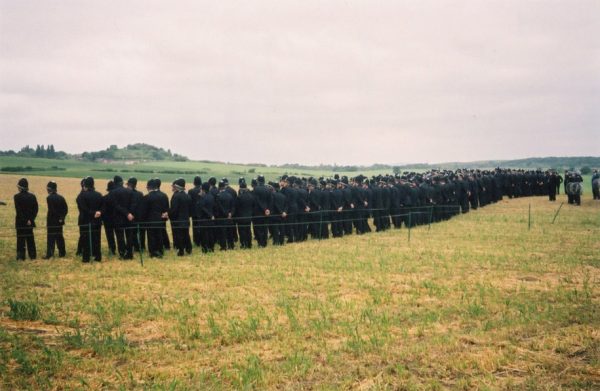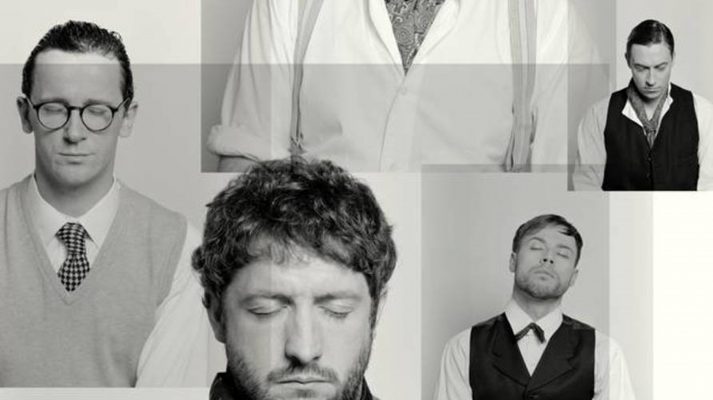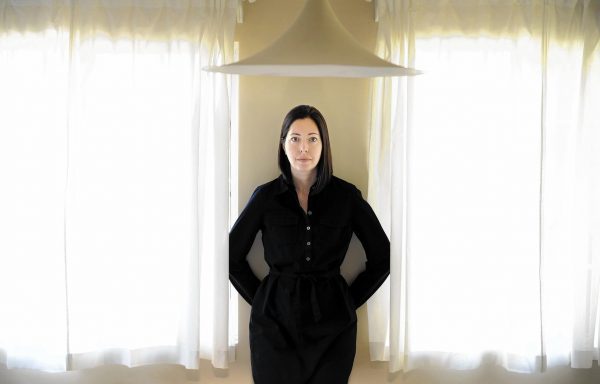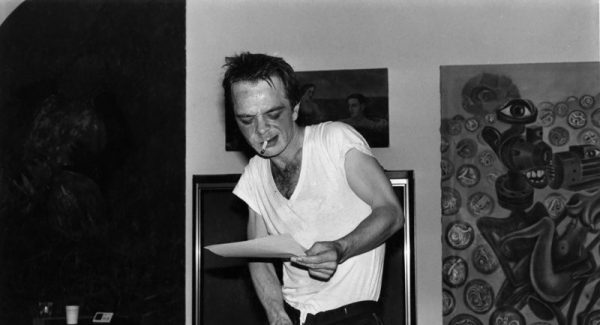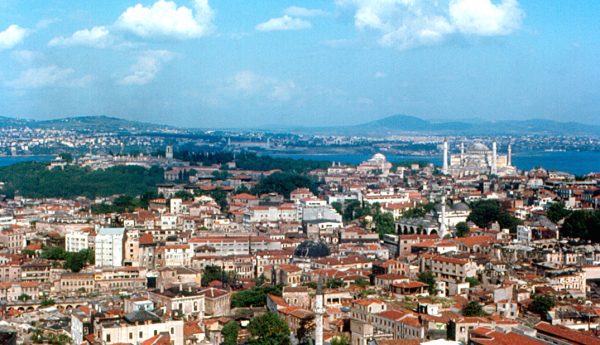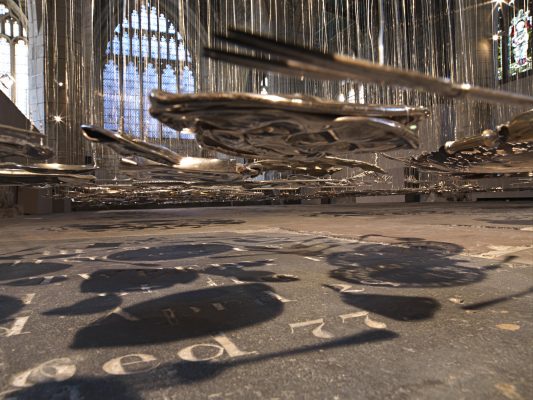‘The past is a foreign country: they do things differently there.’ The immortal first line to L. P. Hartley’s The Go-Between wistfully condenses the problems inherent to memory and history. Distant, intangible, unreliable, lost, our histories, at the levels of personal and national, are at best half-remembered and at worst actively misrepresented. Within the sphere of contemporary art, and more specifically moving-image, artists seem increasingly to be responding to the challenges posed by reconstituting the past in order to chart collective and individual memory through a strategy of re-enactment.
The function and effect of such work is powerful: as academic Andreas Huyssen states, ‘[the] past is not simply there in memory … it must be articulated to become memory.’ A number of video works in the past decade have interacted imaginatively with archives and the documentary genre in order to reanimate marginalised stories and revisit personal or collective traumas. In the latter case re-enactment draws on psychotherapeutic methods used in the treatment of post-traumatic stress. In ‘talk therapy’ the patient is asked to discuss the traumatic experience, and through cognitive analysis find some way through the damage wrought. Treatment is continued through ‘exposure therapy’ in which a patient is made to confront the very thing that they fear, and through repetition learn strategies to cope with it. Re-enactments also provide the artist with a means of representing the past using a theatricality that through its distancing of the viewer deconstructs history as truth, allowing for fresh interpretation. Writer Rebecca O’Dwyer, defending re-enactment in contemporary art against charges of conservatism, reads it instead as an active form of remembering through which we can establish a new relationship to the past, a past understood as being in a constant state of flux. Here we examine six moving image works that negotiate the past through reconstruction and re-enactment.
Jeremy Deller, ‘The Battle of Orgreave’, (2001)
Excerpt from The Battle of Orgreave from Artangel on Vimeo.
For this Artangel commission, a masterpiece of re-enactment, Jeremy Deller orchestrated a re-staging of the violent confrontation between striking miners and riot police in South Yorkshire in 1984. The performance featured 800 collaborators, two thirds of whom were historical re-enactment veterans. The remaining third was comprised of miners and policemen who had, seventeen years previously, taken part in the confrontation.
This act of reunion formed the pivotal element of the piece. Each participant’s physical inhabitation of this episode of history, both as live performance and as framed by the film, brought this piece of working class near-history to the attention of viewers for whom the confrontation had yet to be memorialised. Deller’s investigation of Orgreave was thus an action charged with political potential as well as a poetic work of art. The documentary film – directed by Mike Figgis – reveals both the scale of the undertaking and the poignancy of both sides revisiting the intense emotions of the day. That poignancy is exaggerated by the convivial church fête atmosphere fostered by the erection of tents displaying archival documents, food and tea stands, and the attendance of participants’ families. These latter details contribute a sense of absurdity to the project.
Important to our reading of the re-enactment is the fact that some miners chose to play policemen and vice versa, the artwork thus allowing them to inhabit a different subjectivity through which they could gain a perspective of the action from the other side of the battle line. To understand the full force of Deller’s achievement, one might imagine an artist restaging a particular episode from the 2011 London riots.
Gillian Wearing, ‘Bully’ (2010)
‘Bully’ features amateur actors re-enacting the violent assault of a young man by a group of tormentors. The victim here takes on two roles, of victim and director, instructing the actors in their roles as bullies. The actors begin awkwardly, attempting to take direction and fit into their roles. As the piece unfolds their ‘playing’ becomes increasingly convincing. At the emotional climax the director transfers his very real rage and upset onto the actors playing the bullies. The strategy of re-enactment follows a therapeutic line in that the young man is able to revisit his original fear and vulnerability in a safe environment. However the strength of the emotions unleashed in all of the participants is liable to overspill as boundaries between director and actor, theatrical and real are shown to be inherently unstable.
Joshua Oppenheimer, The Act of Killing, (2012)
A former Ph.D. student at Central St Martin’s, Joshua Oppenheimer pushes the boundaries of film, documentary and artistic practice. Searing and surreal, The Act of Killing sees the filmmaker track down the perpetrators of the Indonesian genocide of 1965 in which over one million people were brutally murdered. Sickeningly, these men are not only still free but actively boast of their exploits and are venerated to this day by the regime that took power as a result of their actions. Oppenheimer describes the sensation of filming in Indonesia as similar to the experience of arriving in Germany forty years after World War II, with the Nazis still in power. The point at which this film diverges from the traditional documentary format is when the director asks the killers to re-visit and re-create their crimes . The bizarre and disturbing results blur the lines between fact and fiction and bring into sharp relief the strategies through which we process the past. As documentary distorts into re-enactment, the theatrical fantasy world of men who got away with murder is revealed on screen. This filmic narrative acts as an expression of an internal one that has been desperately crafted in order to justify the severity of the crimes committed, the brutality of which is never denied. Re-enactment here provides an exploration of the psychological impact of those events and the documentary functions as a mechanism by which to cope with trauma.
Redmond Entwistle, ‘Walk-Through’ (2012)
What truth lies behind a legend? How can the essay film format begin to explore a moment that took place forty years previously? These questions run through Walk-Through, a subtle and measured work by Redmond Entwistle that explores CalArts, the Los Angeles-based university that hosted the Post-Studio class of Mike Asher, a course that revolutionised art pedagogy and introduced the ‘crit’, a teaching strategy now ubiquitous in arts education. Using archival imagery, architectural plans, lingering shots of slamming doors and long corridors, Entwistle traces the ethos of the school and the history of its foundation. Central to the film’s thrust is a session in which actors ventriloquise interviews with original CalArts students. A jarring distancing is achieved in these sequences through each actor’s unconvincing delivery, reminding the viewer that this is a partial, reconstructed history, patched together from the archival fragments and subjective oral accounts. Here, at a pivotal moment for cultural capital, we try to piece together the ‘truth’ from actors whose narratives are disturbed by whispered lines fed into their ears, and an omniscient narrator’s interruptions with statistics and financial information. The intersection of democratic dialogic exchange with the politics and economics of high capital is enacted.
Jesse Jones, ‘The Selfish Act of Community’ (2012)
In Jesse Jones’s film, drama and therapy are explicitly intertwined. We sit in on the re-creation of a group session involving a cross section of American citizens staged by American psychologist Carl Rogers in 1968. The camera slowly rotates in the middle of the group, enacting a theatre in the round. The motion also provides a slightly discombobulating disconnect between what is being said and seen – the focus here is on reaction more than the delivery, speech rather than act. As with Walk-Through, the actor’s delivery is slightly jarring, forcing the viewer to remember that actors inhabit the words and gestures. As with ‘Walk-Through’, the actor’s delivery is jarring, forcing the viewer to remember that actors inhabit the words and gestures. That these individuals are in the past and therefore even more distant from us is reinforced by dated language – one young woman is delighted to be referred to as a ‘broad’ – and the 1960s costumes. This Brechtian technique of gestus points the viewer to the social and economic realities of the scenario. As this cross section of society is brought together to respond to each other as a community we are reminded of their different experiences of different strata of the American population, and in particularly the frustrations of the female participants with their objectification as ‘mother’ or ‘lotus flower’.
Gerard Byrne, various works included in his exhibition at the Whitechapel Gallery, A State of Natural Pleasure (2013)
Byrne is one of the most consistent auteurs of re-staging in contemporary art. His recent retrospective at the Whitechapel Gallery featured a series of work that re-enacted various moments: a radio conversation between Frank Stella and Donald Judd, a Playboy interview between science-fiction writers discussing the future, a reprisal of a car advert featuring Frank Sinatra, another Playboy panel discussing the state of sex in the 1970s and a Surrealist discussion of sex organised by André Breton in 1928. Aside from introducing the viewer to powerful and revelatory moments of social and art history, Byrne’s works bring to light the limitations of each moment of social or aesthetic revolution. In the Lovelace group discussion a member interrupts a group sex discussion to declare that he feels he ‘owns’ his wife, whilst the Surrealists reveal a misogyny and homophobia that repudiates their reputation as sexual pioneers. In the latter film the sense of theatricality is pronounced. The camera pulls back to reveal a rickety studio set, the costumes are over the top, teeth are whitened, the acting style is overt, and speech is carefully scripted and delivered. Here again we are distanced from the action, encouraged to analyse their performances as encompassing a specific political and social philosophy. The composite nature of history and memory was also eloquently expressed through the installation of three of Byrne’s films on the ground floor of the gallery. Sections of each flashed up on different tilted screens, moving the viewer across the space in an attempt to keep up with the narrative, easily distracted and drawn into another film.
share
ABOUT THE CONTRIBUTOR
Natasha Hoare
is Associate Curator at Witte de With Centre for Contemporary Art, Rotterdam. She has worked as Assistant Curator for the Visual Arts Section of the Marrakech Biennale 5 (2014) and for On Geometry and Speculation, a parallel project for the Marrakech Biennale 4 (2012). Her book of interviews with international curators will be published by Laurence King in 2015.
